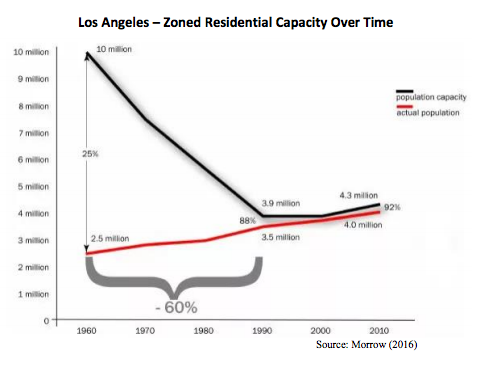In releasing a Housing Development Toolkit earlier this week, the U.S. Department of Housing and Urban Development amplified a growing chorus of voices calling for reform to regulations that limit housing production. The report states, “The increasing severity of under-supplied housing markets is jeopardizing housing affordability for working families, exacerbating income inequality by reducing workers’ access to higher-wage labor markets, and stifling GDP growth by driving labor migration away from the most productive regions.”
In its opening discussion of the prevalence of local barriers to housing development, the report draws on UCLA Lewis Center scholars several times. First, the report cites PhD alumnus Greg Morrow’s work in a discussion of Los Angeles that is a case study for what local cities should not do. Morrow showed that in 1960, Los Angeles was zoned for 10 million people; after decades of increasingly stringent housing regulations, it is now zoned for only 4.3 million, a figure only slightly higher than the city’s actual population of 4.1 million. This tightness in the housing market has led to spiraling price increases.
The report also cites recently completed research by UCLA Lewis Center Faculty Fellows Michael Lens and Paavo Monkkonen. They showed that density restrictions are associated with increased income segregation, and that increased state (rather than local) control over land use is associated with lower levels of segregation. Citing Lens and Monkkonen, the report emphasizes “the key role that states can play in ensuring access to affordable housing.”
As far as policy prescriptions, the report highlights “good work being done” around the country — examples of how states and local jurisdictions have taken action. Among others, these actions include:
- Allowing development by-right
- Enacting high-density and multifamily zoning
- Eliminating off-street parking requirements
- Allowing accessory dwelling units
- Employing inclusionary zoning
In this list, the White House is reiterating policy prescriptions that UCLA Lewis Center scholars have recommended for years, and in some cases, for decades. Several of these policy prescriptions are the very same ones that Lens and Monkkonen advise at the end of their study “Do Strict Land Use Regulations Make Metropolitan Areas More Segregated by Income?” Wherever parking reform is on the table, credit must go to Professor and Lewis Center Faculty Fellow Donald Shoup, who has revealed–over many years–the deep and insidious ways in which parking requirements degrade the fabric of cities, and limit housing production. In calling on cities to allow accessory dwelling units, the White House validates Faculty Fellow Vinit Mukhija’s long-standing interest in the informal city, and in these small, often illegal backyard homes that can provide affordable housing for the elderly, young adults, and low-income people. Finally, Herbie Huff’s applied research in Cudahy is a pilot project of sorts for pushing forward some of these reforms in a small, under-resourced city.
It’s often hard to discern the practical value of research, and the extent to which research findings affect public policy. The Obama administration’s Housing Development Toolkit is an important indicator of the importance of our work here at the Lewis Center. It validates the relevance of our research on housing and on the interrelations between housing and other urban systems; the housing affordability crisis has become sufficiently dire and widespread that it is being addressed by the White House as a national problem. It is specifically heartening that when the White House addressed this matter, with its voice of authority, it drew on research and policy prescriptions from the UCLA Lewis Center.
